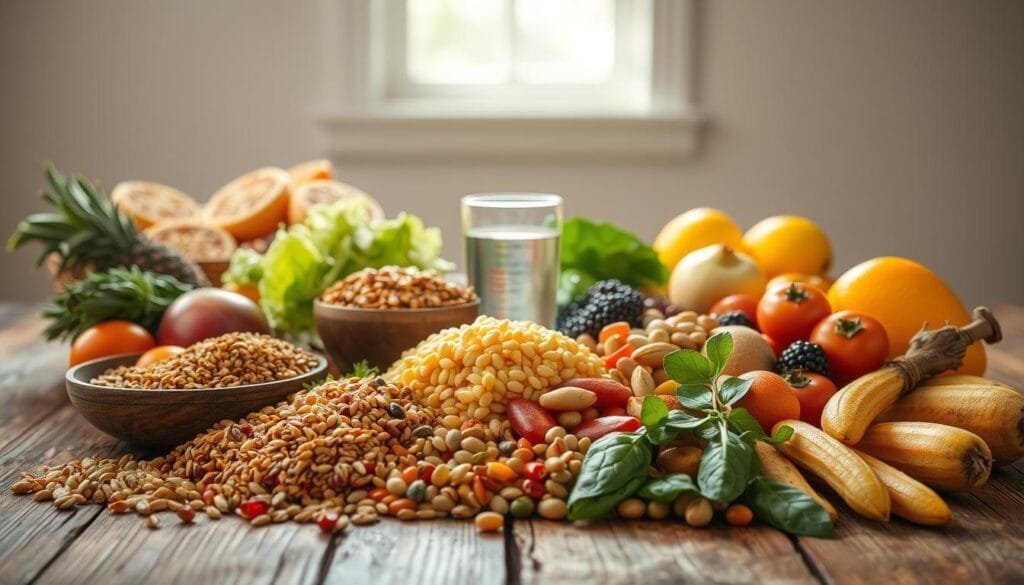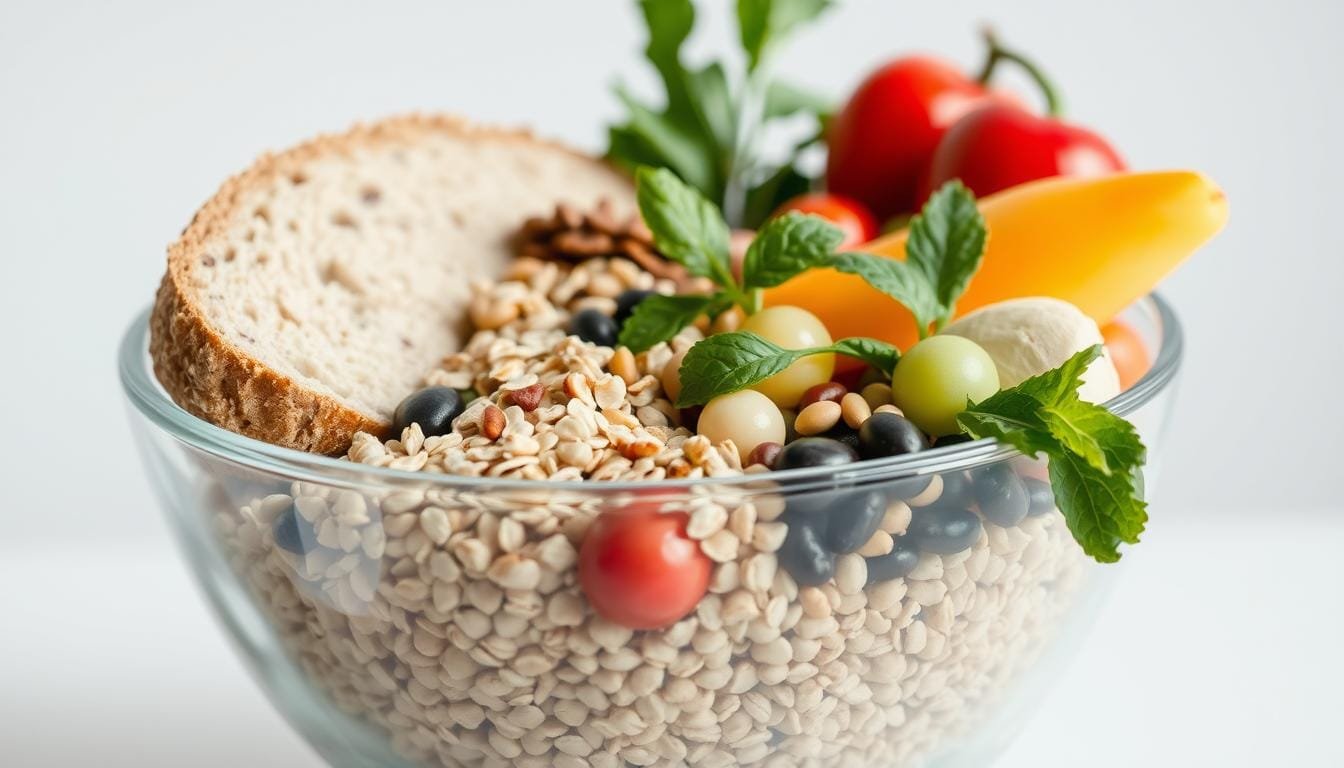Currently Empty: RM0.00
Did you know that only 5% of Americans meet their daily fiber needs? For those managing diabetes, this shortfall can have serious consequences. Fiber plays a crucial role in stabilizing blood sugar, supporting heart health, and maintaining a healthy weight—yet 90% of diabetics struggle to consume enough.
Wellness Concept specializes in guiding individuals toward better nutrition, especially for diabetes care. The right fiber intake can directly impact glycemic control, reducing spikes and crashes. But how much is ideal? This article breaks down science-backed recommendations to help you make informed choices.
For personalized advice, reach out to Wellness Concept on WhatsApp at +60123822655. Learn more about the health benefits of fiber in our detailed guide.
Key Takeaways
- Fiber helps regulate blood sugar and supports heart health.
- Most diabetics fall short of daily fiber targets.
- Proper intake can improve glycemic control.
- Wellness Concept offers expert diabetic nutrition guidance.
- Science-backed recommendations ensure optimal health.
Why Fiber Is Essential for People with Diabetes
Fiber isn’t just about digestion—it’s a game-changer for blood sugar stability. For those managing diabetes, it slows carbohydrate absorption, preventing sudden spikes. This makes meals easier to balance while supporting long-term health goals.
The Role of Fiber in Blood Sugar Control
Soluble fiber forms a gel-like substance in the gut. This slows digestion, helping regulate blood sugar levels and reducing insulin demands. Studies show it can lower post-meal glucose spikes by up to 30%.
Beyond glucose, fiber binds to LDL cholesterol, removing it from the body. This dual action supports both metabolic and cardiovascular health for people with diabetes.
Additional Health Benefits of Fiber
Fiber cleanses the digestive tract, reducing colon cancer risk. Its mechanical cleansing effect promotes regular bowel movements and gut microbiome diversity.
Research also links high-fiber diets to a 15% lower risk of heart disease. Plus, fiber’s satiety benefits aid weight management—a key factor in diabetes control.
Types of Fiber: Soluble vs. Insoluble
Not all fiber works the same—knowing the difference matters for blood sugar control. Dietary fiber splits into two types: soluble and insoluble. Each plays a unique role in diabetes management and overall health.
Soluble Fiber: The Blood Sugar Stabilizer
Soluble fiber dissolves in water, forming a gel that slows digestion. This helps regulate blood sugar levels by preventing rapid glucose spikes. Oat beta-glucan, a type of soluble fiber, boosts insulin sensitivity by up to 40%.
Top Malaysian-friendly sources include:
- Oats (4g per cup)
- Apples (4.4g per medium fruit)
- Black beans (15g per cooked cup)
Insoluble Fiber: The Digestive Champion
Insoluble fiber adds bulk to stool, keeping the digestive tract moving. It reduces constipation, a common issue for diabetics. Unlike soluble fiber, it doesn’t dissolve but acts like a scrub brush for the gut.
Best local sources:
- Whole wheat (12g per cup)
- Almonds (3.5g per ounce)
- Broccoli (5g per cooked cup)
| Type | Function | Top Sources (Malaysia) | Per Serving (g) |
|---|---|---|---|
| Soluble | Slows glucose absorption | Oats, apples, black beans | 4–15g |
| Insoluble | Supports bowel regularity | Whole wheat, almonds, broccoli | 3.5–12g |
Pro tip: Steam vegetables lightly to preserve fiber content. Overcooking breaks it down, reducing benefits. For more on optimizing gut health, explore how fiber improves digestion naturally.
How Much Fiber Should a Diabetic Have a Day?
Balancing fiber intake is crucial for those managing diabetes. The right amount supports blood sugar control, digestion, and heart health. But targets vary based on age, gender, and health needs.
General Recommendations by Age and Gender
The American Diabetes Association (ADA) suggests specific daily intake ranges:
- Men: 30.8–33.6 grams per day
- Women: 22.4–28 grams per day
These values ensure digestive health and metabolic balance. However, diabetics often need more—up to 44–50 grams under medical guidance.
Tailoring Fiber for Diabetes
Not all carbs are equal. High-fiber foods with a low glycemic load—like oats or lentils—prevent spikes. Pair them with proteins for steady energy.
Sudden increases can interfere with medications. Start with small additions, like 5 extra grams weekly. Hydration is key to avoiding discomfort.
“Personalized plans from experts like Wellness Concept ensure safe, effective fiber adjustments.”
For Malaysians, local staples like whole grains and legumes make meeting targets easier. Always consult a professional before major dietary changes.
Best High-Fiber Foods for Diabetes Management
Smart food choices play a vital role in stabilizing blood sugar. Fiber-rich options slow digestion, prevent spikes, and keep energy levels steady. Here’s a breakdown of the top picks for diabetics.
Whole Grains and Legumes
Whole grains like brown rice (3.5g/cup) outshine white rice (0.6g) in fiber content. They’re staples in Malaysian diets and pair well with legumes for a balanced meal.
Top local options:
- Black beans (15g/cooked cup) – Soak overnight to reduce carbs.
- Lentils (13g/cooked cup) – Quick-cooking and versatile.
- Barley (6g/cup) – Adds chewiness to soups.
Fruits and Vegetables Rich in Fiber
Fruits like guava (9g/fruit) offer the highest fiber among tropical options. Vegetables retain nutrients whether fresh or frozen—just avoid overcooking.
Best picks:
- Papaya (5g/cup) – Supports digestion.
- Spinach (4g/cooked cup) – Lightly steam to preserve fiber.
- Okra (4g/cup) – A local favorite in curries.
Nuts and Seeds as Fiber-Packed Snacks
A handful of nuts (15 almonds = 3.5g) makes a satisfying snack. Chia seeds (10g/oz) can be added to drinks or yogurt for a boost.
Watch out: Processed “high-fiber” bars often contain hidden sugars. Stick to whole foods for the best results.
“Pair fiber with protein—like almonds with Greek yogurt—for lasting energy.”
Delicious High-Fiber Meal Ideas for Diabetics
Eating well with diabetes doesn’t mean sacrificing flavor—just adding more fiber. These meal ideas blend local Malaysian ingredients with science-backed nutrition. Each dish supports blood sugar control and keeps cravings at bay.
Fiber-Packed Breakfasts to Start the Day
Overnight oats with chia seeds deliver 12g of fiber per serving. Top with local fruits like papaya or guava for extra nutrients. For a savory twist, try scrambled tofu with spinach on whole-grain toast.
Quick options for busy mornings:
- Chia pudding with almonds (10g fiber)
- Whole-wheat roti with lentil curry (8g fiber)
Lunch and Dinner Recipes with a Fiber Boost
Stir-fried tempeh with bitter melon offers 14g of fiber per plate. Pair it with brown rice for a balanced meal. Traditional dishes like laksa can be modified with zucchini noodles and extra beansprouts.
“Fiber-rich lunches prevent afternoon crashes, keeping insulin levels steady.”
| Day | Meal | Fiber (g) | Carb:Fiber Ratio |
|---|---|---|---|
| Monday | Black bean curry + quinoa | 18 | 3:1 |
| Tuesday | Grilled fish with broccoli | 12 | 2:1 |
For weight management, swap white rice with barley or cauliflower rice. Wellness Concept’s personalized meal plans tailor these ideas to individual needs. Contact them for recipes optimized for your lifestyle.
Tips for Increasing Fiber Intake Safely
Boosting fiber in your diet requires strategy to avoid discomfort. A sudden surge can overwhelm the body, leading to bloating or cramps. Gradual adjustments paired with hydration make the process seamless.

How to Avoid Digestive Discomfort
Start by adding 5 grams of fiber every 3–4 days. This slow ramp-up lets the gut adapt without stress. Pair high-fiber foods with probiotics, like yogurt, to ease the transition.
Common issues and fixes:
- Bloating: Soak beans overnight to reduce oligosaccharides.
- Gas: Chew thoroughly and eat smaller portions.
- Cramps: Opt for cooked veggies over raw initially.
The Importance of Drinking Enough Water
Fiber absorbs water to function properly. Aim for at least 2 liters daily to prevent constipation. Herbal teas or infused water with lemon add variety.
“A 1:1 ratio of fiber (grams) to fluid (ounces) keeps digestion smooth.”
Raw whole grains contain phytates, which can hinder nutrient absorption. Light toasting or fermenting neutralizes these compounds. For personalized management plans, Wellness Concept offers consultations Monday–Friday, 9 AM–5 PM.
Conclusion
Managing diabetes effectively involves smart dietary choices, and fiber plays a key role. Aim for 25–35 grams daily, blending soluble and insoluble types for balanced health benefits. Small, gradual changes prevent digestive discomfort while improving blood sugar control.
Wellness Concept offers personalized nutrition coaching to tailor fiber intake to individual needs. Their experts guide clients in selecting local, fiber-rich foods that fit Malaysian lifestyles.
For support, reach out via WhatsApp at +60123822655. Business hours are weekdays 9:30 AM–6:30 PM and weekends 10 AM–5 PM. Start your journey toward better management today.
FAQ
Why is fiber important for people with diabetes?
Fiber helps regulate blood sugar levels by slowing digestion, preventing spikes. It also supports heart health and weight management, both crucial for diabetics.
What’s the difference between soluble and insoluble fiber?
Soluble fiber dissolves in water, forming a gel that slows glucose absorption. Insoluble fiber adds bulk to stool, aiding digestion and preventing constipation.
How many grams of fiber should diabetics aim for daily?
Most adults need 25–38 grams per day. Those with diabetes may benefit from the higher end of this range to improve glycemic control.
What are the best high-fiber foods for diabetes?
Whole grains like quinoa, legumes such as lentils, fiber-rich fruits (berries, apples), and vegetables (broccoli, Brussels sprouts) are excellent choices.
Can increasing fiber intake cause digestive issues?
Rapidly adding too much fiber may lead to bloating. Gradually increase intake and drink plenty of water to ease digestion.
Are nuts and seeds good fiber sources for diabetics?
Yes! Almonds, chia seeds, and flaxseeds provide healthy fats and fiber, making them great snacks for blood sugar management.
How can diabetics add more fiber to meals?
Swap refined grains for whole grains, add beans to salads, or snack on veggies with hummus. Small changes add up over time.



